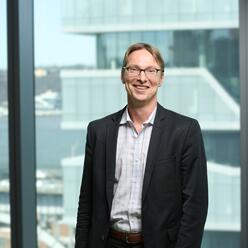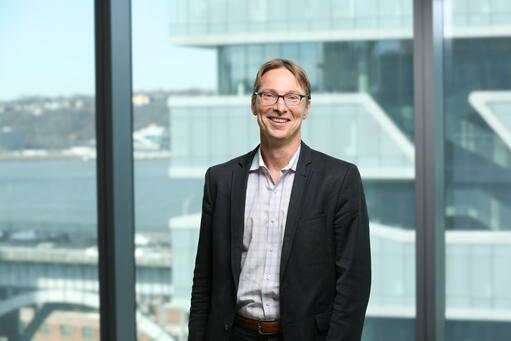The state of New York City's commercial real estate industry was forever changed by the COVID-19 pandemic. The growing trend of remote and hybrid work has severely reduced office space occupancy, to approximately 40 percent of pre-pandemic levels, according to commercial real estate leasing data. Reduced occupancy has in turn led to commercial real estate values decreasing by as much as 50 percent in some areas of the city.
It's this lack of occupancy and devaluation of real estate that forms part of the theory behind the “urban doom loop,” a bleak phenomena coined by Columbia Business School's Stijn Van Nieuwerburgh, the Earle W. Kazis and Benjamin Schore Professor of Real Estate.
The cycle works like so: As remote work continues to lower commercial real estate values, the city will collect less revenue from real estate taxes. As revenue decreases, municipal services are cut, leading those with the means to move out to do so, further reducing sales and income tax revenue. Businesses close, leading to empty storefronts, less foot traffic, and increased crime. This in turn makes people feel unsafe and leave the city in droves, reducing office and business occupancy and restarting the doom loop.
“New York City has lost something like 400,000 people since the onset of the pandemic. So that's a big number,” Nieuwerburgh says. “And if we don't stop this doom loop, this situation could sort of spiral out of control like it did in the 1970s in Detroit.”
But not all hope is lost. Last month, Nieuwerburgh joined CBS's Sheena Iyengar, the S.T. Lee Professor of Business, in hosting a roundtable workshop aimed at investigating and solving the root causes of the urban doom loop. Hosted by The Hub at CBS, the event included senior executives from real estate and banking, government policymakers in real estate and housing, tenants and community members, and academics.
The stakeholders pooled their knowledge to explore potential solutions for halting the doom loop. They included new forms of affordable housing, ways to stimulate office conversions, new financing modes, and creative uses. At the end of the workshop, real estate developers, investors, and government policymakers voted on their top solutions, as listed below.
1. Property Tax Abatement and Other Incentives
Many workshop participants were keen on reviving New York City's 421-g program, a tax incentive program that permitted developers to receive property tax exemptions and abatements when converting commercial buildings within Lower Manhattan into residential units. While the 421-g program expired in 2006, participants said a new form of the program would be necessary to outweigh the risks of conversion construction projects, which often offer less returns compared with ground-up development projects.
Participants also noted that for a modern 421-g program to be politically feasible, it would have to include an affordable housing requirement. The original 421-g program, which began in the 1990s, allowed converted buildings to be exempt from increases in assessed values for eight years and receive a 14-year property tax abatement, among other benefits. Units were mandated to be rent stabilized throughout the duration of these benefits but could be removed from rent stabilization after the benefits expired.
A new program could expand on the foundation laid by 421-g by offering set formulas for exemptions and abatements instead of a single required affordability threshold. Thus, the size of the benefit would be based on the share of affordable units. Participants also suggested that the affordability of units could be based on different area median income bands instead of a single AMI threshold for all units.
2. Increasing the Appetite for Lending
The creation of a lender credit program modeled after the Community Reinvestment Act of 1977 could spark the lending needed to kick office-to-residential conversions into high gear, according to many of the participants with financial and banking backgrounds. Many banks hesitate to lend for conversion projects due to the high risk involved. However, the implementation of a CRA-type program could sweeten the pot.
In the current commercial real estate market, capital is scarce and banks are much more likely to lend to ground-up projects rather than conversions. When the CRA was passed in 1977, it mandated that all banks that receive Federal Deposit Insurance Corporation insurance offer fair loans in the communities they operate in, to counteract redlining and act as a catalyst for housing development in low- and middle-income communities.
A recent revision to the CRA was passed in October 2023, with a phase-in process beginning January 1, 2026. The revision expands the program in a few key areas that could be used for office-to-residential conversion projects in New York City. For starters, the CRA will now provide for an impact and responsiveness review factor that “considers whether loans, investments, or services directly facilitate the acquisition, construction, development, preservation, or improvement of affordable housing in High Opportunity Areas.” This includes all areas designated by the U.S. Department of Housing and Urban Development as a “difficult development area,” or DDA.
Nearly all of New York City's Central Business District census tracts are listed as DDAs, allowing conversion projects within these census tracts to count toward the CRA's impact and responsiveness review of community development financing tests.
Second, the recent changes to the CRA allow for the partial eligibility of credits on affordable housing projects that include less than a majority of affordable housing units. Under the revised rule, affordable housing projects with less than a majority of affordable units may be eligible for partial credits in proportion to the number of units that are affordable, as dictated by the local or state jurisdiction, as long as the project utilizes some form of government support, including property tax incentive programs.
Under the revised rules, were New York state to implement a new property tax abatement program in support of office-to-residential conversions with an affordability component, all projects would qualify for at least a partial CRA credit tied to the proportion of affordable housing units within the project.
3. Reinvesting in Creative Spaces
As the vacancy rate of commercial real estate in Lower Manhattan increases and in turn the population there falls, the area's vibrancy and creative output will be affected.
Many participants with arts backgrounds noted how in years past, artists and the creative industries have been the first to use and repurpose underutilized spaces. They cited effective repurposing in many cities of former industrial and retail buildings into creative spaces.
In some office buildings in New York City, creative uses may be limited by existing zoning and building codes. However, the city government could create programs or pass legislation that lightens restrictions to allow more artists and creative industries access to underutilized office spaces. In time, creative uses could potentially bring additional benefits to neighborhoods, including increased foot traffic, more storefronts, and greater property tax values through increased residential demand.
Additionally, public spaces in these areas could further benefit from public realm investments, such as garbage containerization, increased outdoor dining space, public art displays, and beautification projects.


